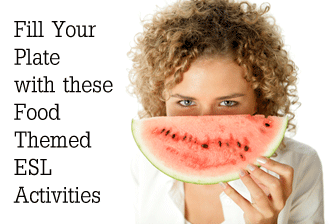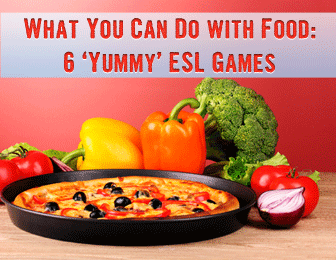Fill Your Plate with these Food Themed ESL Activities


Of course, for practical purposes, food vocabulary is taught in ESL classes through flashcards and illustrations. But wouldn’t it be “glorious” to actually use real food? Or at the very least plastic, toy food?
Rotten Apples
Tell your class they’ll be going to the market today! Divide your class into shoppers and stall owners. Give each stall owner a booth (a desk) and a set of plastic fruits or veggies they must sell at $1 each. Give your shoppers $30 in play money. Give them enough time to go around and shop for fruits and vegetables. They must use the expressions and phrases they’ve learned for shopping. Then call out the name of one of the items, say “apples” and tell them they’re rotten. All of the students who bought apples must place them in a separate container – the “trash”. Allow them to continue shopping and then call out the name of another “rotten” item. At the end of the game, the student who has the most items – the one who relinquished the fewest “rotten” items - wins.
Eating Out
There is no better way to practice ordering food in restaurants than by actually getting a plate of food! Set up a kitchen area with the set of plastic food you have available. As a warm up activity, have your students create a couple of menus that include the foods they have to offer. They can draw on their menus, use images they have cut out from magazines or simply list the items. Go over the different categories that are usually found in menus: drinks, appetizers, entrees, and desserts.
When the menus are ready, students take turns eating out and serving the food in your restaurant. You may even have several “tables” at once with several waiters. Waiters and waitresses go to the kitchen to fill the orders, but if a particular item is no longer available they must go back to the table and offer an alternative: I’m sorry, we have run out of Coke. Would you like some juice instead?
Food Pyramid
Teach your students how to eat a healthy, balanced diet. Use the Nutrition Worksheet combined with a good variety of plastic foods. There are several activities suggested in the worksheet, but there’s no better way to get the point across than by using real or plastic foods.
Thanksgiving Celebration
How do you explain to an ESL student the food that the pilgrims ate for Thanksgiving? Isn’t it a lot better to taste it? Have your own special Thanksgiving celebration with your class and sample some traditional dishes like pumpkin or apple pie, berries, or cornbread. Since carving a turkey in the classroom is not very feasible, you can have turkey sandwiches instead. Other holidays you can celebrate with real food include Halloween, Christmas, the Fourth of July or Easter.
A Race for Health
This is a wonderful activity for your youngest learners. Start a discussion with your students on which foods are healthy and which aren’t. Why is it important to have a healthy diet? Divide your students into two teams. Each team has to line up next to a bin with plastic food. On the other side of the room each team has two trays - one for healthy food and one for junk food. When you blow your whistle, the two students at the front grab a food from the bin, race to the other side, and deposit the food in the correct tray. Students return to the back of the line and the team member who’s next in line does the same. When the time’s up, you check their trays. Have students tell you what each item is and if it’s healthy or not. The team who placed the most food in the correct trays wins.
Fruit Salad
Make a fruit salad with as many fruits as you can. Students take turns being blindfolded and guessing the fruit they’ve been given to taste. You may divide them into teams, give them points for correct guesses, but above all…. let them enjoy a healthy snack!
You may even share the investment with other ESL teachers and have a box of food supplies ready for any of your lessons.
For more great activities, we have plenty of Food, Fruit and Vegetables, or Restaurant worksheets to guarantee your students will not only learn the right vocabulary, but also learn a valuable lesson in nutrition.